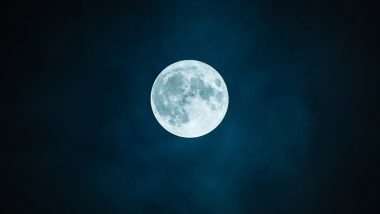In a groundbreaking development, an international team of scientists has confirmed the existence of a substantial cave on the Moon, a discovery that could significantly influence the future of lunar habitats. The cave, located 250 miles (400 kilometres) from the Apollo 11 landing site in the Sea of Tranquility, where Neil Armstrong and Buzz Aldrin made their historic moonwalk 55 years ago, was identified by an Italian-led research team. They meticulously analysed radar measurements from NASA's Lunar Reconnaissance Orbiter (LRO) and compared the results with lava tubes on Earth, leading to this momentous discovery. Buck Moon 2024 Date, Time, Meaning Behind Name and Significance: All You Need To Know About July Full Moon That Coincides With Guru Purnima.
Their findings published in the journal Nature Astronomy, revealed that the Mare Tranquillitatis pit, the deepest known pit on the Moon, leads to a cave approximately 45 metres wide and up to 80 metres long. The cave which lies about 150 metres beneath the lunar surface, is roughly equivalent in area to 14 tennis courts.
The Italian-led research team, who analysed radar data collected by NASA's Lunar Reconnaissance Orbiter (LRO), made a significant breakthrough. Their findings, published in the journal Nature Astronomy, unveiled the Mare Tranquillitatis pit, the deepest known pit on the Moon, leading to a cave approximately 45 meters wide and up to 80 meters long. This cave, lying about 150 meters beneath the lunar surface, is roughly equivalent in area to 14 tennis courts. The team's findings suggest that this cave is a promising site for a lunar base, offering shelter from the harsh surface environment and the potential to support long-term human exploration of the Moon.
The cave, described as “probably an empty lava tube,” by Lorenzo Bruzzone from the University of Trento in Italy, could serve as a natural shelter for future lunar explorers. These underground structures could provide crucial protection from the harsh environment of the Moon, including cosmic rays, solar radiation, and micrometeorites, while maintaining relatively stable temperatures inside. This potential for safety and stability is a significant step forward in lunar exploration.
“Lunar caves have remained a mystery for over 50 years. So it was exciting to be able to finally prove the existence" of one, Leonardo Carrer and Lorenzo Bruzzone of the University of Trento, wrote in an email, reported Associated Press.
NASA is working towards building a semi-permanent crewed base on the Moon. Moreover, China and Russia have also shown interest in creating lunar research outposts. However, a permanent lunar base can only be set up in environments protected from cosmic radiation and with stable temperatures.
The research suggests that this cave, like the more than 200 other pits identified on the Moon, likely formed through the collapse of lava tubes, which are large underground tunnels created by ancient volcanic activity. These lava tubes could provide important advantages for establishing lunar bases, as they require fewer construction efforts and provide inherent structural protection.
“Lunar orbiters first spotted pits on the moon more than a decade ago,” said Leonardo Carrer, the study's first author. “Many are thought to be skylights that connect to underground caves, such as lava tubes,” he added.
The discovery of the substantial cave on the Moon by the international team of scientists marks a monumental step in the future of lunar exploration and habitation. With the backing of detailed research and advanced radar measurements, this finding paves the way for the establishment of a lunar base, crucial for sustained human presence on the Moon. This discovery not only brings us closer to realizing permanent lunar outposts but also enhances our understanding of the Moon's geological history and potential as a second home for humanity.
(The above story first appeared on LatestLY on Jul 16, 2024 11:12 AM IST. For more news and updates on politics, world, sports, entertainment and lifestyle, log on to our website latestly.com).













 Quickly
Quickly



















